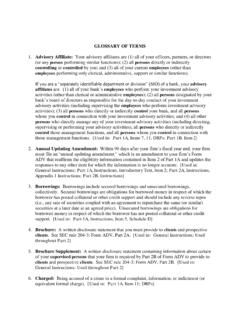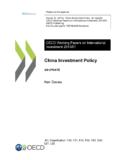Transcription of GLOSSARY OF FOREIGN DIRECT INVESTMENT TERMS AND …
1 INVESTMENT Division, Directorate for Financial and Enterprise Affairs Organisation for Economic Co-operation and Development 2 rue Andr -Pascal, Paris 75116, France GLOSSARY OF FOREIGN DIRECT INVESTMENT TERMS AND DEFINITIONS This GLOSSARY forms part of the 4th Edition of the OECD Benchmark Definition of FOREIGN DIRECT INVESTMENT and is intended to assist both the compilers and users of DIRECT INVESTMENT statistics. Acquisition An acquisition is a business transaction between unrelated parties based on TERMS established by the market where each enterprise acts in its own interest.
2 The acquiring enterprise purchases the assets and liabilities of the target enterprise. In some cases, the target enterprise becomes a subsidiary or part of a subsidiary of the acquiring enterprise. Activity of Multinational Enterprises In principle quantitative or qualitative information directly concerning multinational firms could be classified under activity of multinational enterprises. However, within the framework of the OECD Handbook on Economic Globalisation Indicators, data on the activity of multinationals covers all economic and industrial data which are not associated with FDI, portfolio or other financial transactions.
3 Data collected by the OECD within the framework of the surveys on the economic activity of multinationals include 18 variables, notably gross output, turnover, value added, number of people in employment, employee compensation, gross operating surplus, gross fixed capital formation, R&D expenditures, number of researchers, total exports and imports, intra-firm exports and imports, and technological payments and receipts. Affiliated enterprises Affiliated enterprises are enterprises in a DIRECT INVESTMENT relationship.
4 Thus, a given DIRECT investor, its DIRECT investors, its subsidiaries, its associates, and its branches, including all fellow enterprises, are affiliated enterprises. It is possible for a given enterprise to be a member of two or more groups of affiliated enterprises. All-inclusive concept The application of the all-inclusive concept is one of the two main approaches to measuring earnings. The concept is explained in the International Accounting Standard, Unusual and Prior Period Items and Changes in Accounting Policy.
5 When earnings are measured on the basis of this concept, income is considered to be the amount remaining after all items (including write-offs and capital gains and losses, and excluding dividends and any other transactions between the enterprise and its shareholders or investors) causing any increase or decrease in the shareholders or investors interests during the accounting period, are allowed for. This concept is not recommended by the Benchmark Definition (see also entry on Current Operating Performance Concept).
6 2 Ancillary corporation An ancillary corporation is a wholly-owned subsidiary whose productive activities are ancillary in nature: that is, confined to providing services to the parent corporation and/or other ancillary enterprises owned by the same parent corporation. The kinds of services which may be produced by an ancillary unit are transportation, purchasing, sales and marketing, various kinds of financial or business services, computing and communications, security, maintenance, and cleaning.
7 In some cases, the ancillary unit is located in a different economy from the companies it serves. An ancillary corporation is recognized as a separate institutional unit when it is resident in a different economy from that of any of its owners, even if it is not, in practice, autonomous. Assets, DIRECT INVESTMENT DIRECT INVESTMENT assets can be ascribed to the following three categories: (i) INVESTMENT by a resident DIRECT investor in its non-resident DIRECT INVESTMENT enterprises (ii) reverse INVESTMENT by a resident DIRECT INVESTMENT enterprise in its non-resident DIRECT investor(s) (iii) INVESTMENT by a resident fellow enterprise in non-resident fellow enterprises.
8 Asset/liability principle The asset/liability principle records all FDI financial claims on and obligations to non-residents using the normal balance sheet data showing gross assets and liabilities for positions, and net transactions for each category. The data presented on this basis, while compiled distinguishing the nature of the relationship between the counterparts (according to Framework for DIRECT INVESTMENT Relationships), do not incorporate any offsetting of reverse DIRECT INVESTMENT transactions or positions in equity or debt between a DIRECT INVESTMENT enterprise and its DIRECT investor.
9 Similarly, the asset/liability presentation does not incorporate any offsetting of any transactions or positions between fellow enterprises. Associate, DIRECT INVESTMENT Enterprise An associate is a DIRECT INVESTMENT enterprise (i) in which an investor owns directly at least 10% of the voting power and no more than 50%; (ii) where an investor and its subsidiaries combined own at least 10% of the voting power of an enterprise but no more than 50%, the enterprise is regarded as an associate of the investor for FDI purposes.
10 (iii) where an associate, either as an individual or in combination with its subsidiaries, own more than 50% of an enterprise, this enterprise is regarded for FDI purposes as an associate of the higher level investor. Balance of Payments The Balance of Payments is a statistical system through which economic transactions occurring during specific time periods between an economy and the rest of the world can be summarised in a systematic way. The IMF Balance of Payments and International INVESTMENT Manual provides conceptual guidelines for compiling balance of payments statistics according to international standards.
















